In celebration of the 1812 anniversary year, I am posting an article first published in "First Empire" Number 106 in 2009. This article describes a wargame scenario for a mini-campaign inspired by reading Denis Davidov’s book “In the service of the Tsar against Napoleon”, as translated by Gregory Troubetzkoy. The scenario is based on Denis Davidov’s time as a partisan leader during September and October 1812. The game is comprised of 30 campaign days during which Denis patrols the region around Viazma and Ghatsk looking for French convoys to attack. Denis gains victory points by intercepting and destroying or capturing French troops and supplies, and by raising militia units in the villages and towns through which he passes. The French gain victory points by avoiding contact with Denis, by escaping from his ambushes and by destroying Denis and his partisans.

Note on Names
For the main body of the article I have used names as written in Gregory Troubetzkoy’s translation. My campaign map, however, has been assembled from a variety of sources and I have intentionally used both modern and 19th Century names and/or spellings. Where I have clear identification of the places shown on the map with the places mentioned in the Memoir, I have used the spelling as given in the translation. On the other hand, in those cases where I think I have identified a place mentioned in the translation, but I am not sure, I have used the modern spelling. To date I have yet to identify all of the places mentioned by Denis.
Historical Background
This section is largely based on Denis Davidov’s Memoirs as published in the book “In the Service of the Tsar Against Napoleon, 1806-1814” by Gregory Troubetzkoy (Chapter 6 is devoted to the 1812 campaign). In 1812, Denis Davidov was 28 years old and had served in the Russian army for 11 years(1) . In April 1812 Denis was assigned as Lieutenant Colonel of the Akhtyrka Hussar Regiment, participating in several engagements and skirmishes as the Russian armies retreated towards Moscow. Denis decided that he could be more usefully employed as a leader of partisans and wrote to his benefactor Prince Bagration claiming that partisan warfare was more suited to “my age, my experience and …..my daring!” . On 21st August 1812, Denis was summoned by Prince Bagration. During this interview, Denis persuaded Prince Bagration to present his proposal to General Kutusov, the Commander-in-chief. Kutusov was sceptical about the chances of success but agreed to send one detachment around to the rear of the French Army. Kutusov agreed that Denis should command the detachment but, because of his scepticism, assigned only 50 hussars and 150 cossacks to the detachment. Denis was very disappointed as he wanted a thousand cossacks, and in this he was supported by Prince Bagration, who believed that if it was worth doing at all, it was worth doing properly with a 3000 strong detachment. However Denis agreed to take on the command, hoping that some early successes would convince General Kutusov to reinforce his detachment. In the event, the detachment comprised only 50 hussars and 80 cossacks. The Hussars were taken from Major General Vassilchikov(I)’s brigade(2) and the Cossacks from Major General Karpov(II)’s brigade(3,4).
With this force, Denis set off for his first base of operations at Skugorevo, which is approximately 30 miles south west of Borodino and 24 miles south of Gzhatsk on the main Old Smolensk highway. Denis arrived in Skugorevo on or about 29th August at which time the French advanced guard had reached Viazma. According to Denis, “innumerable carts, transports, convoys and marauding bands followed them on both sides on the road for a distance of 30-40 miles”.

Denis chose Skugorevo because “it was situated on a hill which overlooked the neighbouring area, so that on a clear day one could see out to a distance of 7 or 8 miles” (5). See the map below.
Denis described his objective for the coming weeks as follows;
“I felt that my duty was not to defeat vagabonds but to destroy the French army transports of food and military equipment”
Sometime before 13th September the Governor of Viazma (M. Poincaré(6) ) deployed 2000 cavalry to hunt down Denis Davidov and clear the area between Gzhatsk and Viazma. This detachment was led by General de Brigade Charles-Joseph Evers (a 39 year old from Brussels, who was promoted to General de Brigade in March 1812 (7)). In terms of garrisons, at about this time, the French had the 2nd Battalion, 5th Westphalian Line Infantry at Viazma and the 3rd Battalion, 2nd Westphalian Line Infantry at Gzhatsk(8) .

The following table is a list of the contacts that Denis Davidov’s force made with the French plus some other key information points drawn from the Memoir.
| Date |
Place |
Russian Force |
French Force Encountered |
Result from Denis’s Pespective |
Ref. |
| 2/9 |
Tokarevo |
50 hussars & 80 cossacks |
marauders |
160 prisoners & some wagons captured |
p.88 |
| 2/9 |
Tsarevo-Zaymische |
|
250 cavalry & some wagons |
119 prisoners & 10 wagons captured |
p.89 |
| 5/9 |
Andreyevskoe |
|
marauders |
30 prisoners captured |
p.90 |
| 6/9 |
Federovskoe |
|
50 men accompanying 200 Russian prisoners of war |
Reinforced by 60 ex POWs |
p.90 |
| 8/9 |
Uknov |
300 cavalry
& 170 infantry |
none |
Reinforced by 170 infantry and 2 regiments of cossacks |
p.90 |
| 12/9 |
Viazma |
|
376 men, 20 wagons & 12 artillery caisons |
100 French killed,270 prisoners and all wagons etc captured |
p.93 |
| 14/9 |
Tepulkha |
|
72 men |
Captured 72 prisoners |
p.93 |
| 15/9 |
Tepulkha |
|
260 men & 20 wagons |
All men & wagons captured |
p.93 |
| 19/9 |
Yourenev |
|
3 Polish battalions (600 men?) and 1000 Russian prisoners of war |
120 infantry captured at the cost of 35 men killed |
p.95 |
| 19/9 |
|
|
Artillery park |
24 carriages captured |
p.96 |
| 19/9 |
Pokorovskoe |
|
170 men and 400 Russian prisoners of war |
All French captured and prisoners released |
p.96 |
| 20/9 |
Gorodistche |
Force is now 923 men |
none |
|
p.96 |
| 21/9 |
Znamenskoe |
|
none |
2000 milita raised |
p.113 |
| 23/9 |
Gorodistche |
|
400 marauders |
335 men captured |
p.115 |
| 26/9 |
Monin |
|
|
127 light infantry, 42 wagons & 10 artillery carriages captured |
p.116 |
| 1/10 |
Andreyani |
Reinforced by 500 cossacks, 700 cossacks in total |
none |
|
p.116 |
| 4/10 |
Luzintsov |
|
1 battalion 4th Illyrian regiment |
202 men captured |
p.117 |
| 4/10 |
Vopka |
Approximately 300 cossacks |
Wagon train & escort of approximately 300 men |
41 wagons and escort captured at cost of 15 cossacks killed |
p.118 |
| 4/10 |
Semlev |
|
Wagon train |
Wagons captured |
p.118 |
| 5/10 |
Krutoy |
|
~750 men |
378 French infantry captured and a similar number killed |
p.120 |
| 6/10 |
Losmino |
|
~550 cavalry |
150 French killed and 405 captured at the cost of only 4 killed and 17 wounded |
p.121 |
| 11/10 |
Tepulkha |
|
Wagon train |
231 men & 70 wagons captured, 68 Russian prisoners released |
p. 127 |
| 14/10 |
Losmino |
|
General de Brigade Evers with 2-4000 cavalry |
Russians escaped without significant loss. |
p.128 |

Of these several actions I have picked four examples which I hope will illustrate the whole;
2nd September - Tsarevo-Zaymische: Denis discovered that a convoy of some munitions wagons and 250 cavalrymen were staying in this village. In his own words the attack proceeded as follows;
“In order to take this force completely by surprise, we left the road and cut across fields, taking cover in clumps of woods and small valleys. Three miles short of the village, however, as we reached open space, we encountered some 40 enemy foragers. Seeing us, they fled immediately towards their unit. We had no time for tactical manoeuvres, and leaving 30 hussars…. ….to serve as our reserve, we gave chase to the enemy with the remaining 20 hussars and 70 cossacks. We galloped into the village on the heels of the fleeing enemy, taking everyone by surprise……On our appearance everyone scattered. We took some Frenchmen prisoner without weapons or even clothes, others we dragged out of barns. Only one group of about 30 soldiers tried to put up a fight, but they were routed and quickly cut down.”(9)
This raid resulted in the capture of 121 men and 10 wagons of food and ammunition.
19th September – Yourenev: Expecting to liberate 1000 Russian prisoners at the village of Yourenev, Denis approached the village via the village of Nikolskoe, stopping just short of Yourenev an hour before sunrise. However, unknown to Denis, instead of the prisoners and their escort, 3 weak battalions of Polish infantry had occupied the village (these were possibly the third battalions of the Vistula Legion infantry regiments which had been in Smolensk at the beginning of the month(10). One battalion was in the village proper and the other two were bivouacked behind the church. Attempting to surprise and surround the “escort group” in the village, the initial infantry assault force was decimated by the musket fire of the Polish battalion in the village. Eventually Denis’ infantry managed to surround the village and set fire to it, thereby driving the defending Polish infantry out of the buildings at which point the Chechensky detachment took 120 men prisoner. At this point the other two Polish battalions appeared on the scene and Denis ordered a “gradual retreat”(11).
4th October - Vopka; On the 3rd October Denis divided his force into three groups. One of these groups was led by Company commander Alexander Chechensky and comprised approximately 300 cossacks. Denis described their exploits as follows; “Company commander Chechensky came upon a wagon train with provisions which was passing the night in the woods on the way from Vopka to Viazma. When the enemy spotted our Cossacks, they tried to form the carriages into a semicircle and put up a defence. But Chechensky did not give them time to carry out this move and captured the transport. Then the escort of infantry headed for the centre of the wood and kept up a heavy fire. Chechensky, enraged ordered his men to dismount, pursued the enemy and charged them with fixed bayonets. This brave action completed the defeat, but cost us fifteen of the best Bug regiment cossacks, badly wounded or dead.”(12)
14th October – Losmino; At this time and place, General de Brigade Evers caught up with Denis and a more conventional cavalry contest ensued;
“My vanguard crushed its enemy counterpart but was in turn overwhelmed by the assault by the assault of two enemy squadrons. Instead of withdrawing in scattered formation towards on of the flanks….they continued to mix with the enemy and rode back in disarray towards our main body. If I had not veered hard to the right, they would have been in our midst and created total confusion. Luckily thanks to this quick manoeuvre, we corrected the situation, because we outflanked the enemy chasing our vanguard and quickly put them to flight …….. I realised that the enemy were not in the least upset by the challenge to their vanguard,….. they were moving resolutely forward.
I decided therefore not to oppose their advance and to fall back in order, or to be more precise, disorder….So I called for a scattered withdrawal and designated the village of Krasnoe….. as the new rallying point.”(13)
The Game
Denis Davidov’s Force
At the beginning of the game the Russian player rolls one D6 to determine the size of the initial force;

This simulates the reality that there was considerable debate regarding the strength of the force that should be allocated to Denis. These troops should all be considered as Veterans as Bagration ordered that Davidov be given the best troops(14). Each hussar squadron should be approximately 100 men strong (i.e. 3 figures at 1:33 ratio and 5 figures at 1:20 ratio) and each cossack sotnia should be approximately 60 men strong ( i.e. 2 figures at 1:33 ratio and 3 figures at 1:20 ratio).

Map Movement
Although by no means essential, the players have the option of using map movement on the campaign map, in which case Denis will move each day at a rate determined by the composition of his force;
Cavalry only = 24 miles per day or 4 map squares
Including Infantry, Artillery & Wagons = 18 miles per day or 3 map squares
Denis starts the game at Skugorevo.
The French will however not need to use map movement.
Reinforcements & Rest Days:
At the start of each day the Russian player rolls a D10 and on a score of 10 can add 1 battalion of infantry
or 2 squadrons of hussars
or 6 squadrons of Cossacks to his force with immediate effect.
NB: Unit strengths(15);
“Raw” Infantry Battalion: 400 men; (12 figures @1:33 or 20 figures @ 1:20)
“Trained” Cavalry Squadron: 100 men; (3 figures @1:33 or 5 figures @1:20)
“Trained” Cossack Sotnia: 60 men; (2 figures @ 1:33 or 3 figures @ 1:20)
If, on the other hand, the score is 1 or 2, the Russian force must rest for 1 day and the French force will score
50 Victory Points.
Denis can also add half of any liberated prisoners of war (POWs) to his force as infantry.
The French Forces
On each campaign day, when the Russian force is not resting, the French player should roll one D10. The resultant French force is dependent on how close Denis is to the main highway, after he has made his map movement. If the game is being played without the campaign map, the Russian player is allowed to choose where his forces are.

NB: Unit Strengths(16);
Infantry Company: 66 men; (2 figures @1:33 or 3 figures @1:20)
Infantry Battalion: 400 men; (12 figures @1:33 or 20 figures @ 1:20)
Cavalry Squadron: 100 men (3 figures @1:33 or 5 figures @ 1:20)
Cavalry Regiment: 400 men (12 figures @1:33 or 20 figures @1:20)
Cavalry Brigade: 800 men (24 figures @1:33 or 40 figures @1:20)
Thus, the French score victory points each time Denis fails to find any French troops.
For each French unit, then throw 1D6;

If a French force is discovered, a battle may be fought between Denis’s force and the French force. At this point, Denis can choose not to engage the French, in which case the French are awarded the maximum Victory Points available. On the other hand, the French can choose to surrender, with the Russians getting maximum available Victory Points. The French force will attempt to cross the battlefield and escape from the opposite side of the table. It is assumed that the French are moving along a road.
The battlefield will be approximately 2500 paces square, which in my case is 4 feet by 4 feet as I use 15mm scale troops. The terrain for the battlefield is established using the following system. First use the score of a D10 to determine the number of terrain features. For each terrain feature throw a D10 to determine what it is;
Then each item should be placed on the table as determined by the score of 1D6;

For streams and the road that the French are moving along, throw 2D6 to determine the entry and exit sectors.
Weather Chart; For each battle, roll 1D20 to determine the prevailing weather for the day;

Force Deployment
The Russians will then throw 1 D6 to determine their deployment square. The Russians can be deployed in their formation of choice.
Raising Militia
Once the Russian player has captured wagons, he can start to raise militia companies. This is achieved by spending one campaign day in a village or town. The Russian player needs 6 wagons for each attempt to raise militia. The size of the militia and the victory points scored are determined by the score of 1D6;
 The militia so raised, are “RAW” musket armed infantry, each company is comprised of 100 men (3 figures @33:1 or 5 figures @20:1). One of the companies raised must remain in the village but any others can be added to Denis’s force.
The militia so raised, are “RAW” musket armed infantry, each company is comprised of 100 men (3 figures @33:1 or 5 figures @20:1). One of the companies raised must remain in the village but any others can be added to Denis’s force.
Victory Conditions
If Denis Davidov is killed or captured at any point in the game, the French are declared the winners. Alternatively at the end of 30 days campaigning, the side with the most victory points is declared the winner based on the following schedule;

Concluding Remarks
I hope that you have enjoyed reading this article and that it inspires you to look a little closer at Denis Davidov’s contribution to the defeat of Napoleon. At a time when a lot of Napoleonic wargaming is focussed on the big battles, it is easy to overlook the little ones. I would welcome any input into the game design and corrections of any mistakes I have made.

Bibliography
The following books were consulted during the preparation of this article;
“In the Service of the Tsar against Napoleon, The Memoirs of Denis Davidov, 1806- 1814” Translated and Edited by Gregory Troubetzkoy, 1999.
“1812 - The March on Moscow” – Paul Britten Austin, 1993
“1812 – Napoleon in Moscow” – Paul Britten Austin, 1995
“Napoleon’s Invasion of Russia”- George Nafziger, , 1988
“The Russian Officer Corps in the Revolutionary and Napoleonic Wars” - Alexander Mikaberidze, 2005
“1812 Napoleon’s Russian Campaign” - Richard Rhein (1991)
“1812 Napoleon’s Fatal March on Moscow” – Adam Zamoyski (2004)
References
(1) Alexander Mikaberidze, The Russian Officer Corps in the Revolutionary and Napoleonic Wars (2005), page 66
(2) Alexander Mikaberidze, The Russian Officer Corps in the Revolutionary and Napoleonic Wars (2005), page 424
(3) Alexander Mikaberidze, The Russian Officer Corps in the Revolutionary and Napoleonic Wars (2005), page 182
(4) George Nafziger, Napoleon’s Invasion of Russia, (1988) page 541
(5) Gregory Troubetzkoy, In Service of the Tsar against Napoleon, (1999), page 89
(6) Paul Brittan Austin;1812 Napoleon in Moscow(1995) page 167
(7) Geert van Uythoven, CAVALRY OFFICERS OF THE NETHERLANDS available at http://home.wanadoo.nl/g.vanuythoven/Cavalry%20Officers%201813_15/Cavalry%20Officers%201813_15%20E.htm - NB; this is now a dead link, see also;
Oeuvres diverses du baron de Stassart, Goswin Joseph Augustin de Stassart (baron) , 1854, p.431-2
(8) George Nafziger, Napoleon’s Invasion of Russia, (1988) page 531
(9) Gregory Troubetzkoy, In Service of the Tsar against Napoleon (1999) page 89-90
(10) George Nafziger, Napoleon’s Invasion of Russia, (1988) page 532
(11) Gregory Troubetzkoy, In Service of the Tsar against Napoleon (1999) page 95
(12) Gregory Troubetzkoy, In Service of the Tsar against Napoleon (1999) page 118
(13) Gregory Troubetzkoy, In Service of the Tsar against Napoleon (1999) page 128-9
(14) Gregory Troubetzkoy, In Service of the Tsar against Napoleon (1999) page 86
(15) Richard Rhein, 1812 Napoleon’s Russian Campaign (1991) page 477
(16) Richard Rhein, 1812 Napoleon’s Russian Campaign (1991) page 478




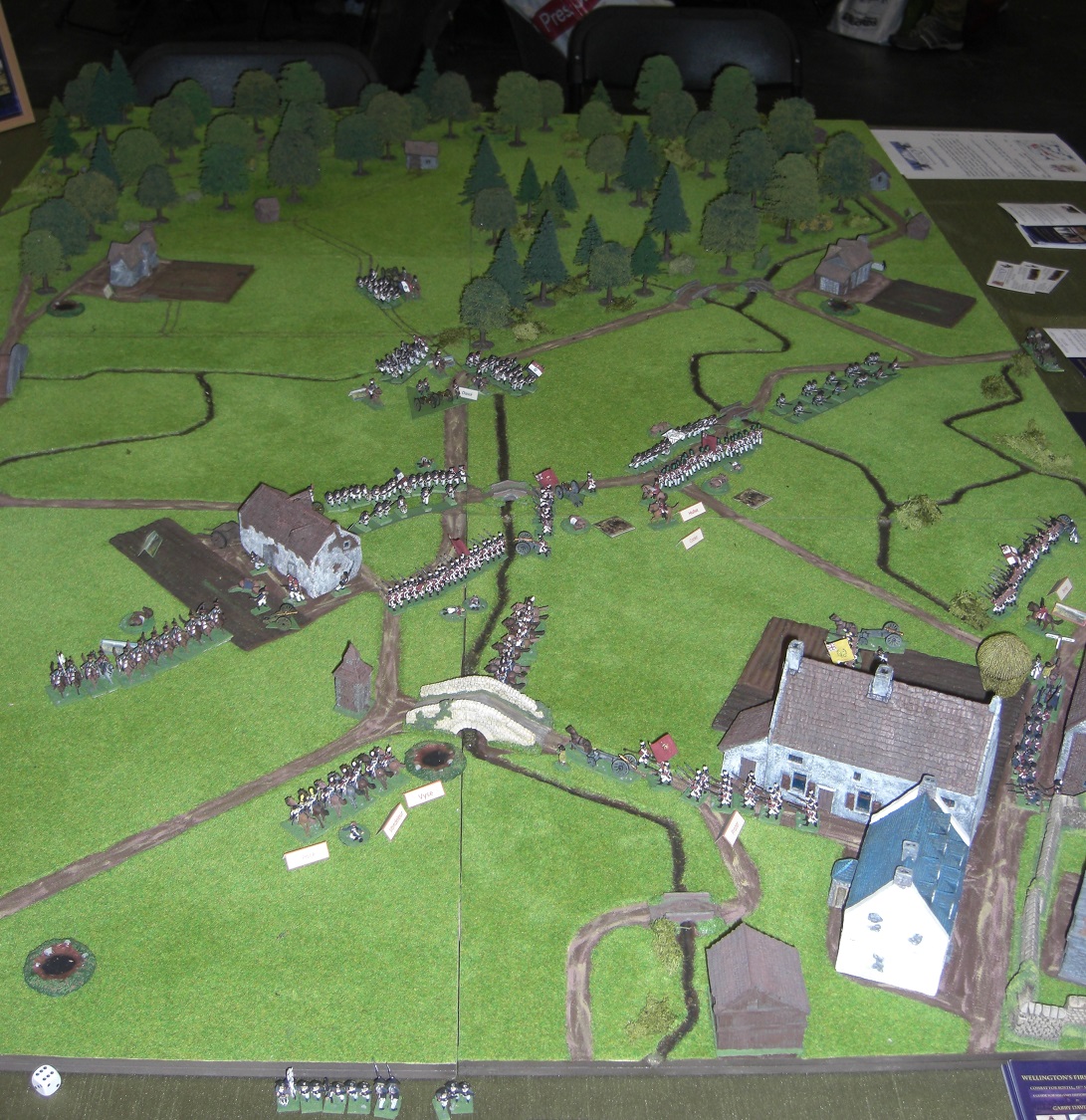


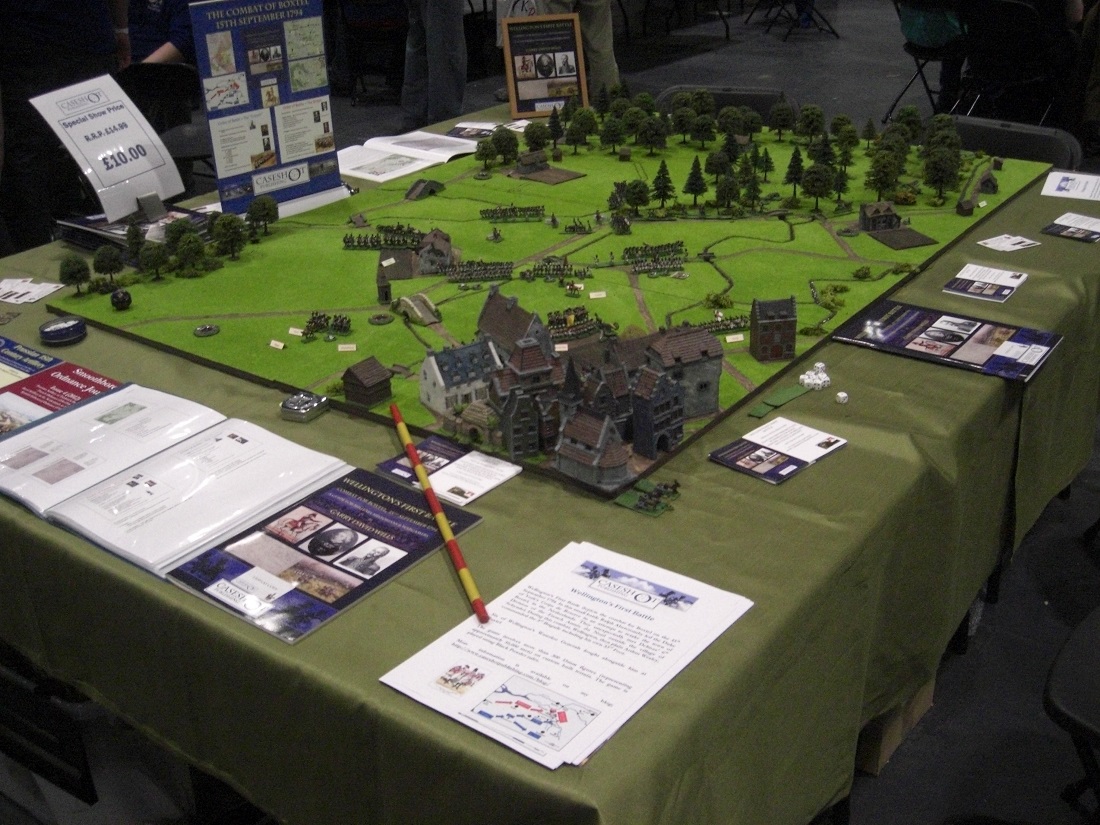
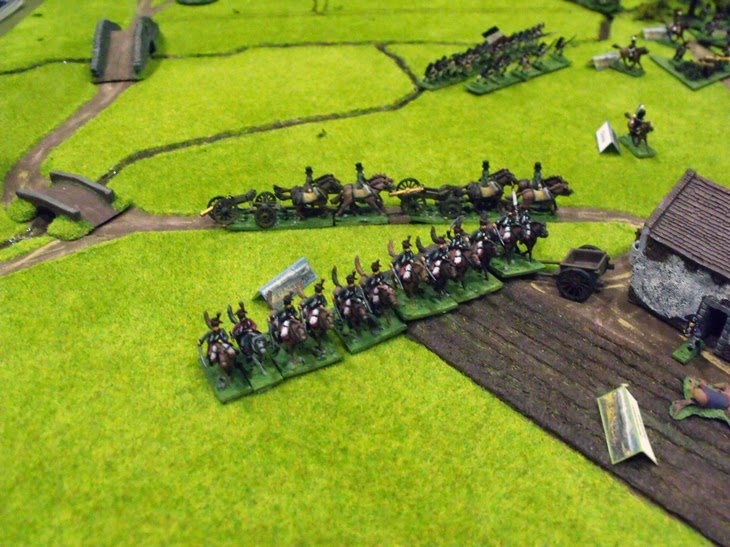


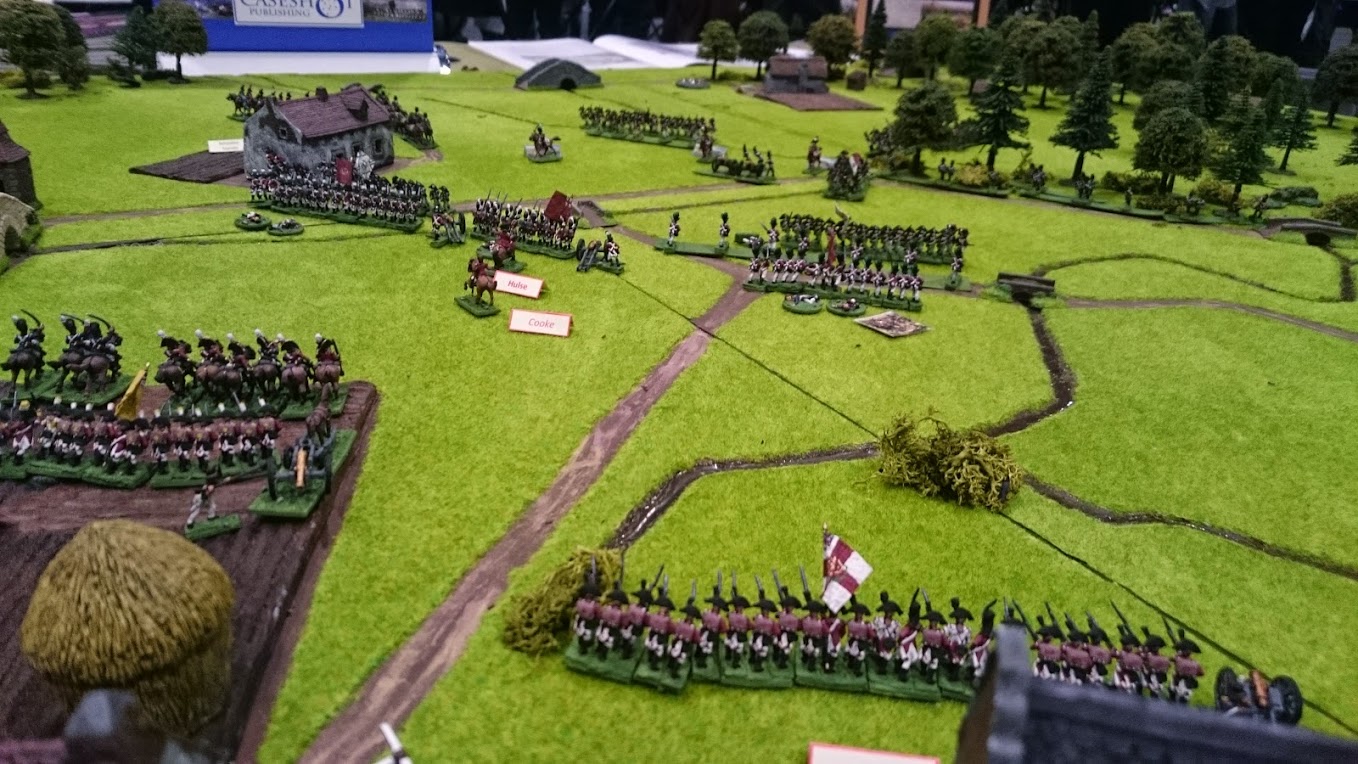
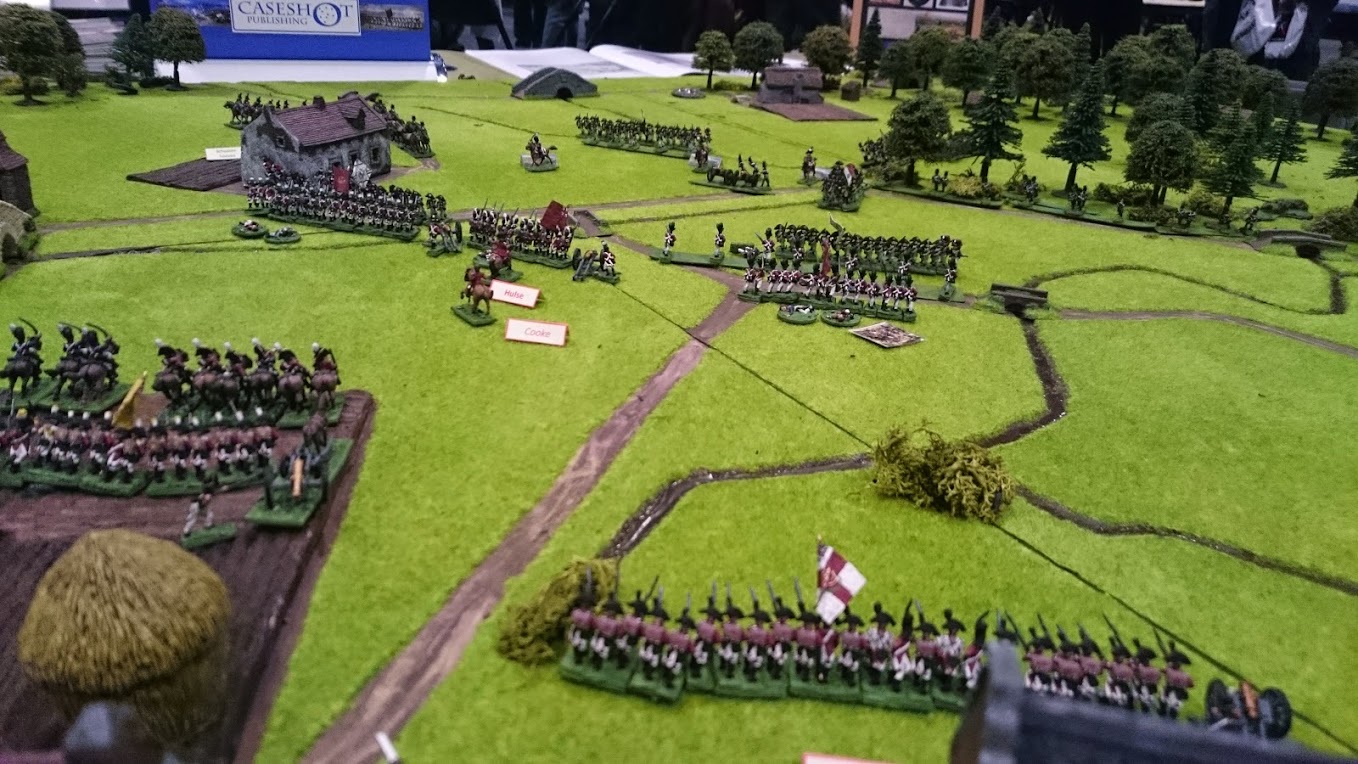
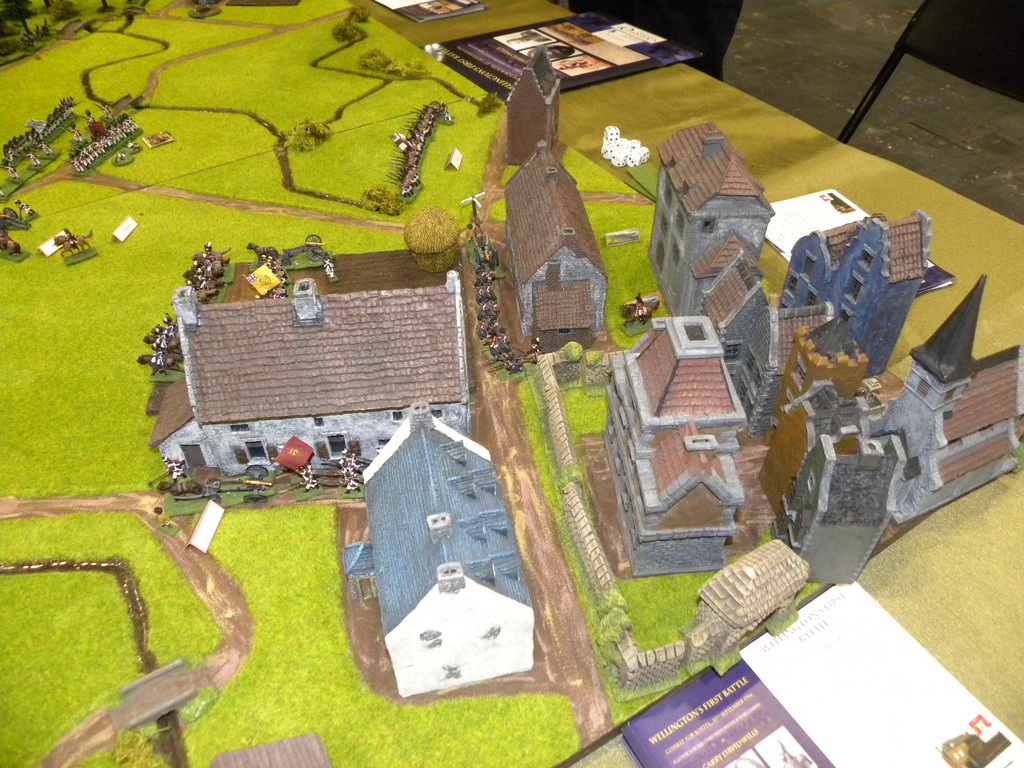


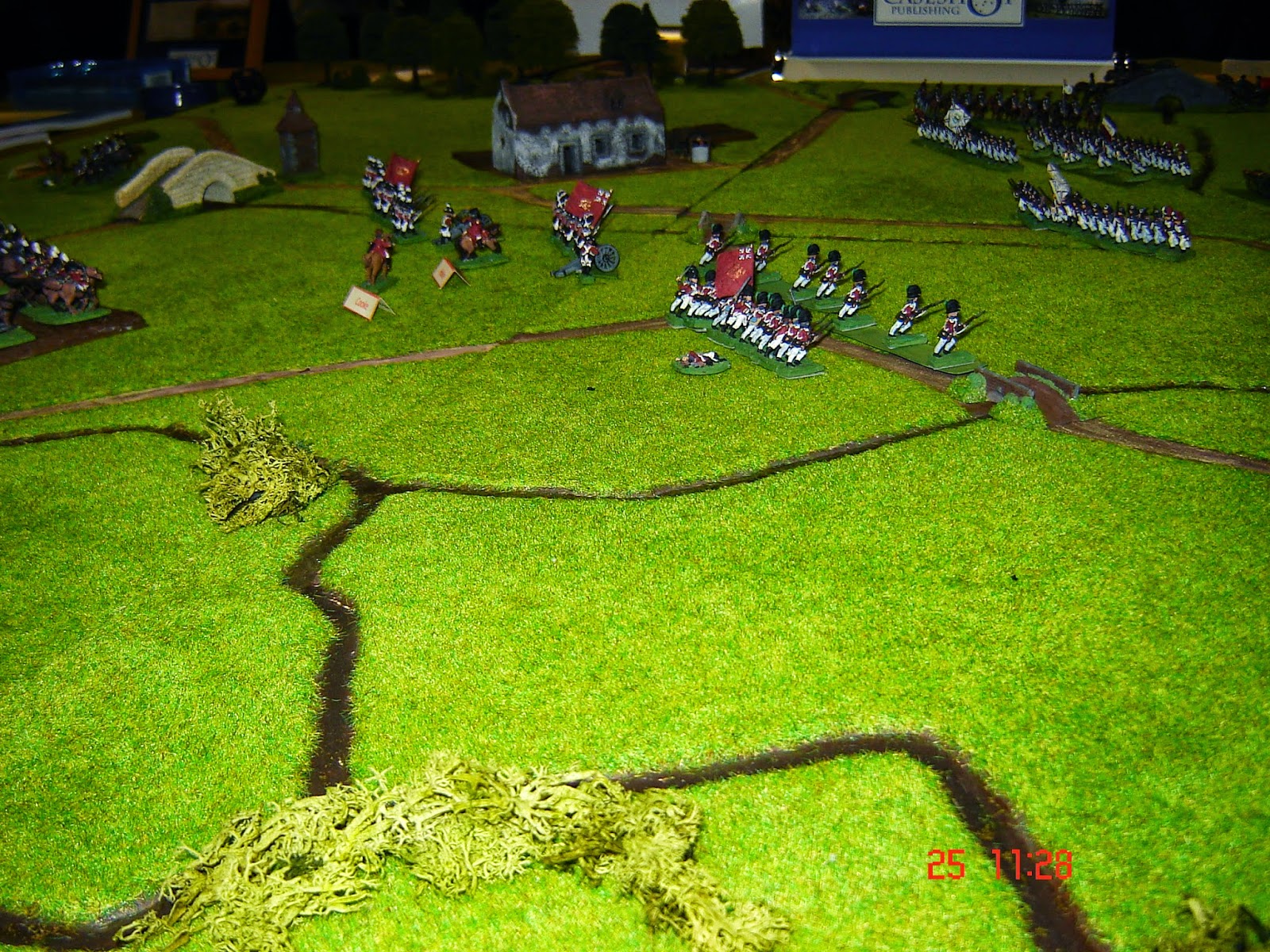
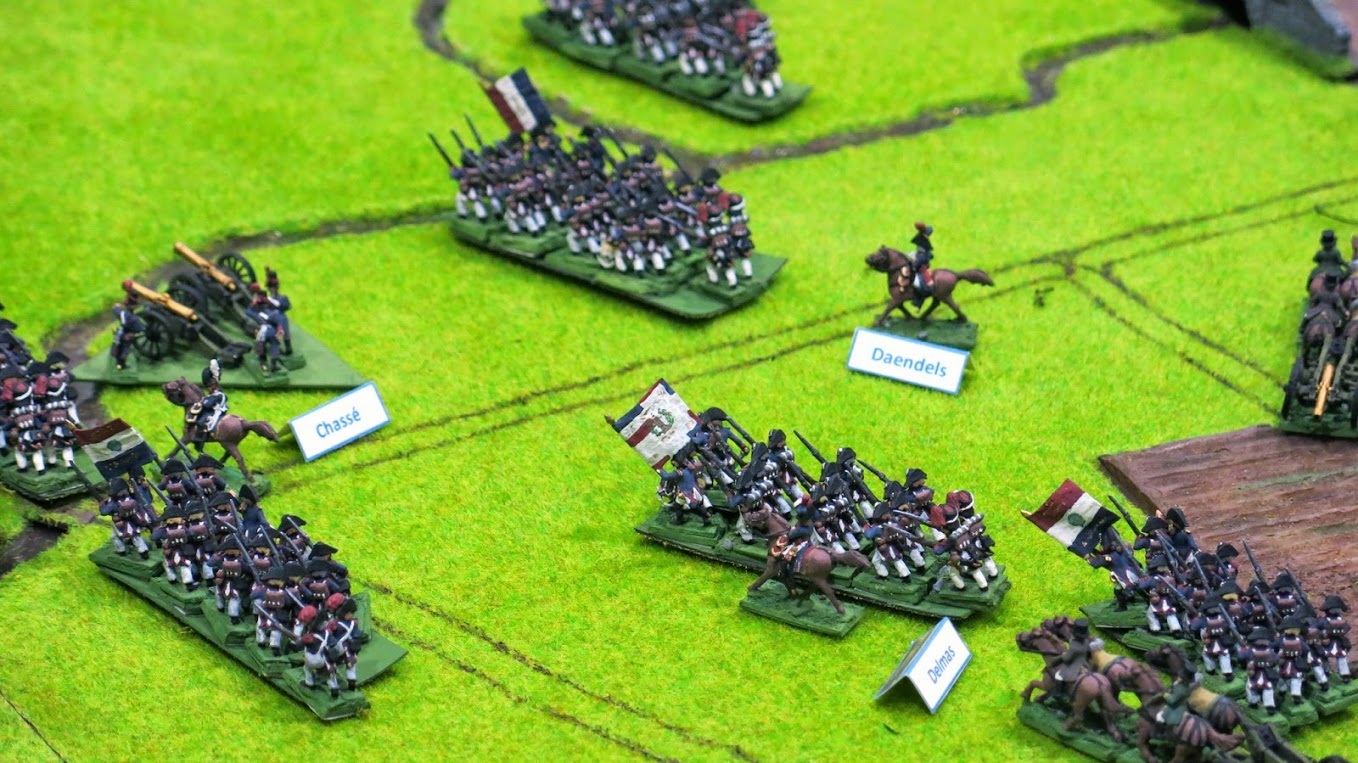
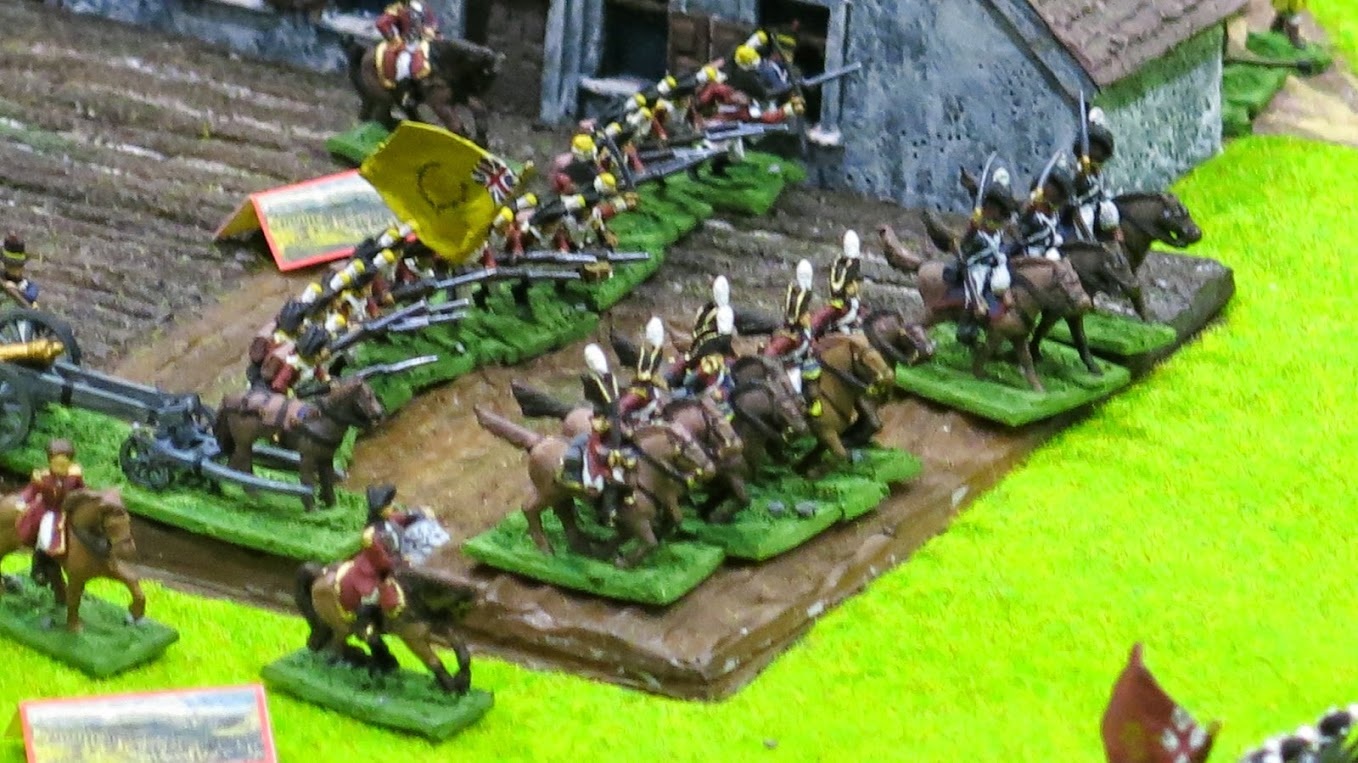
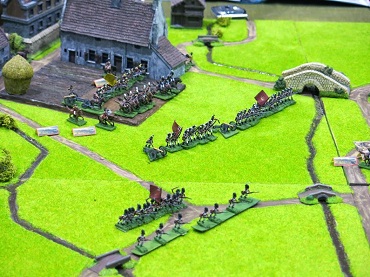



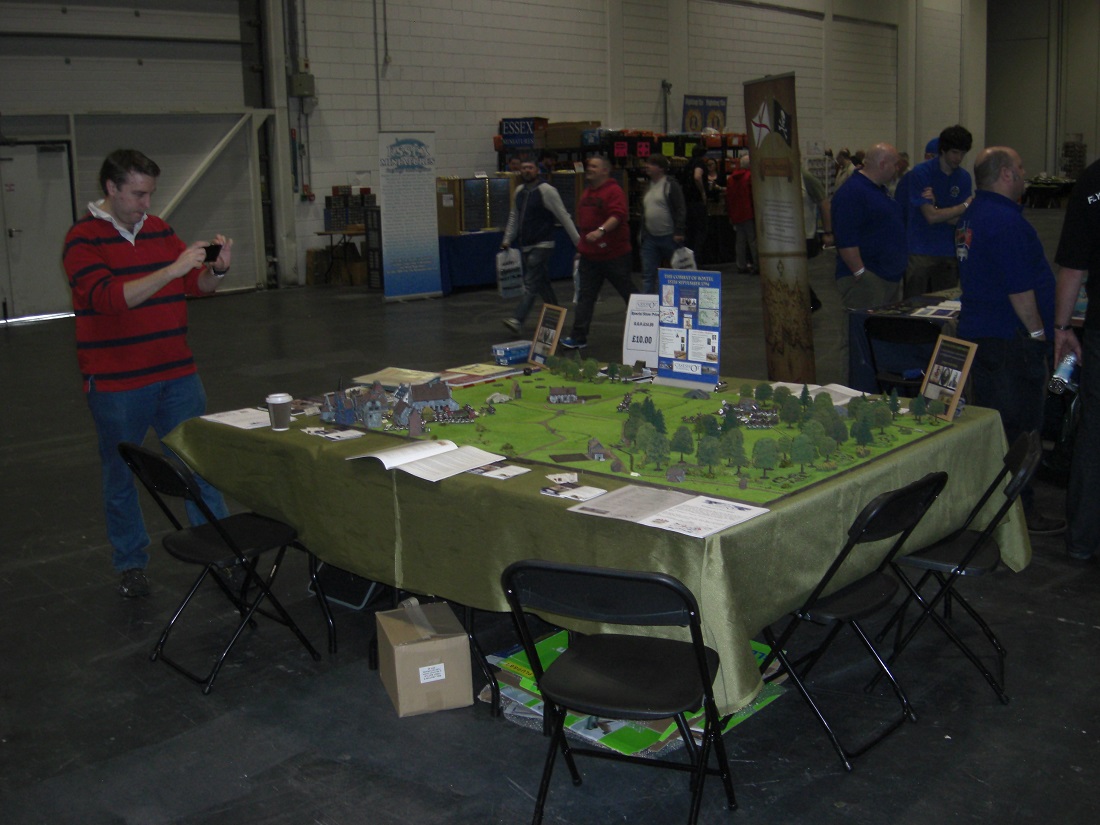
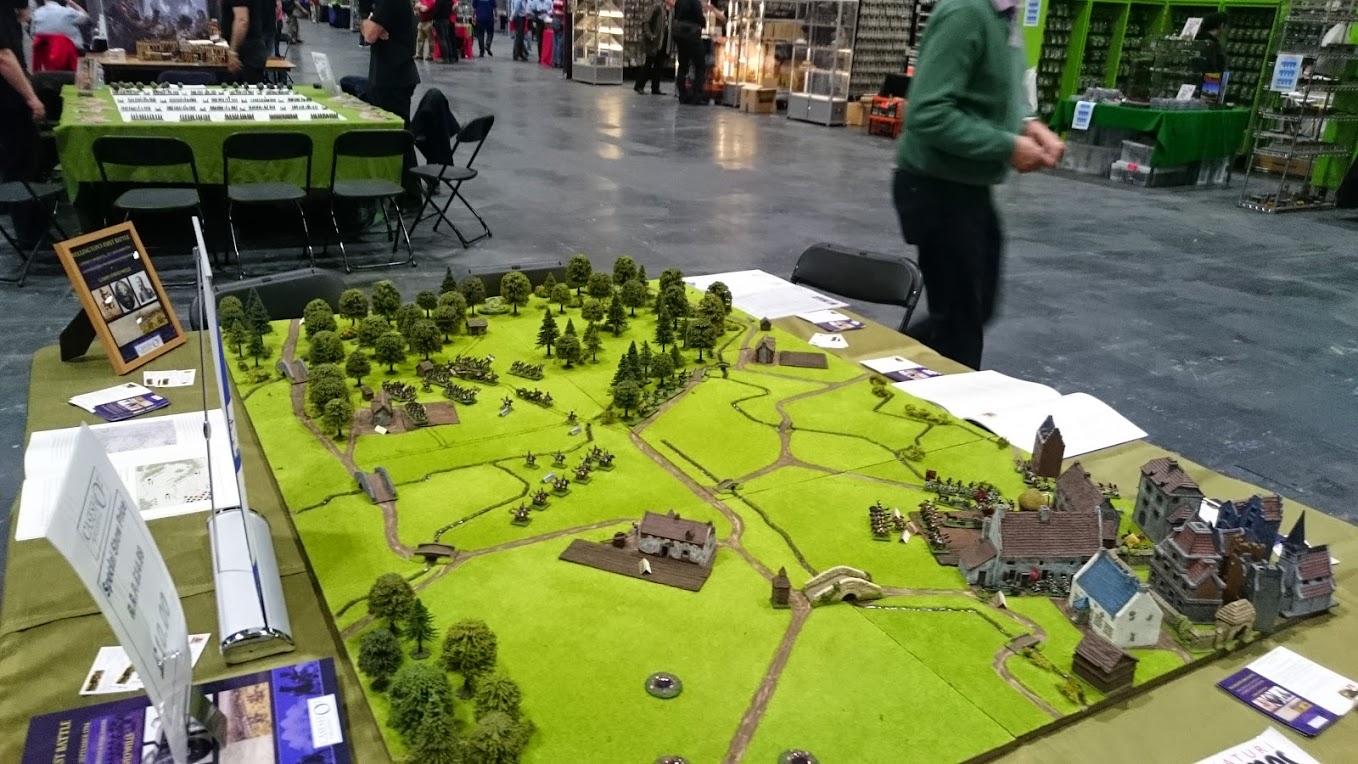
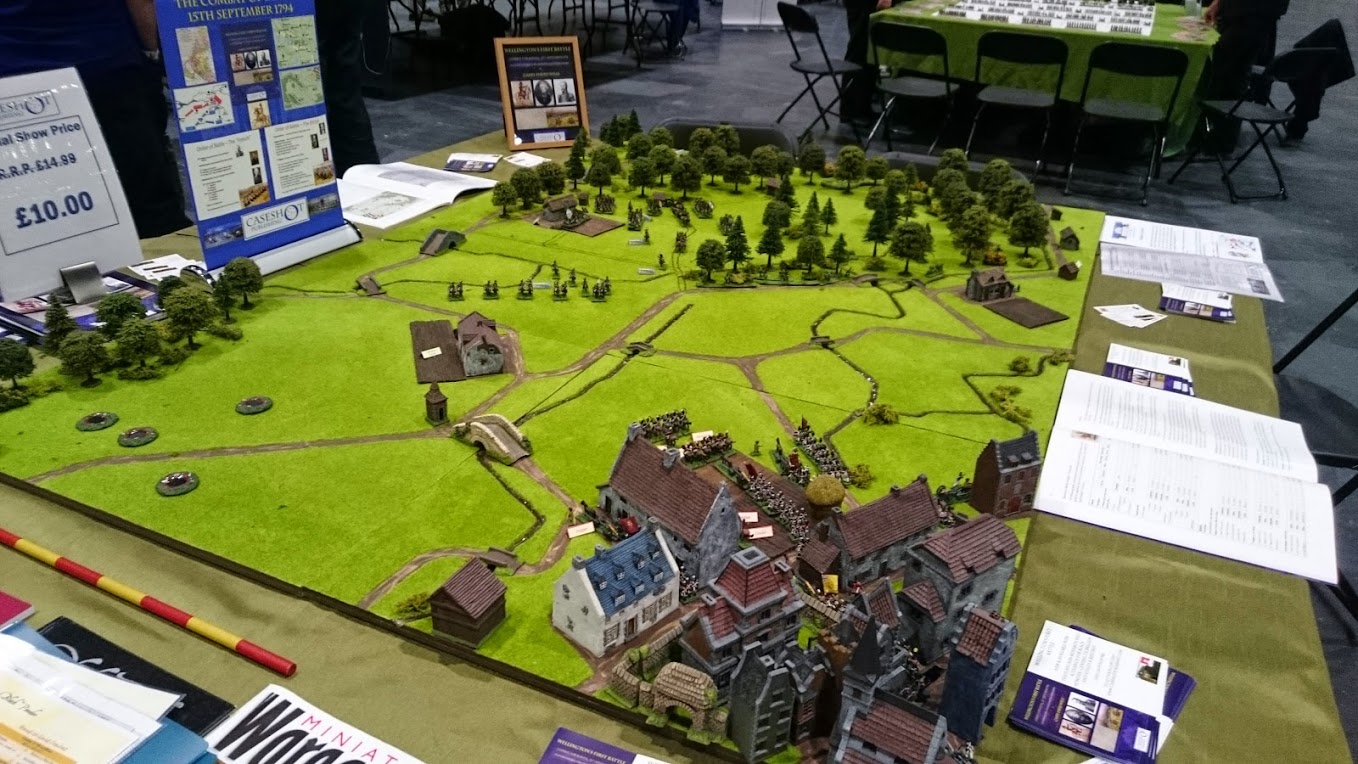
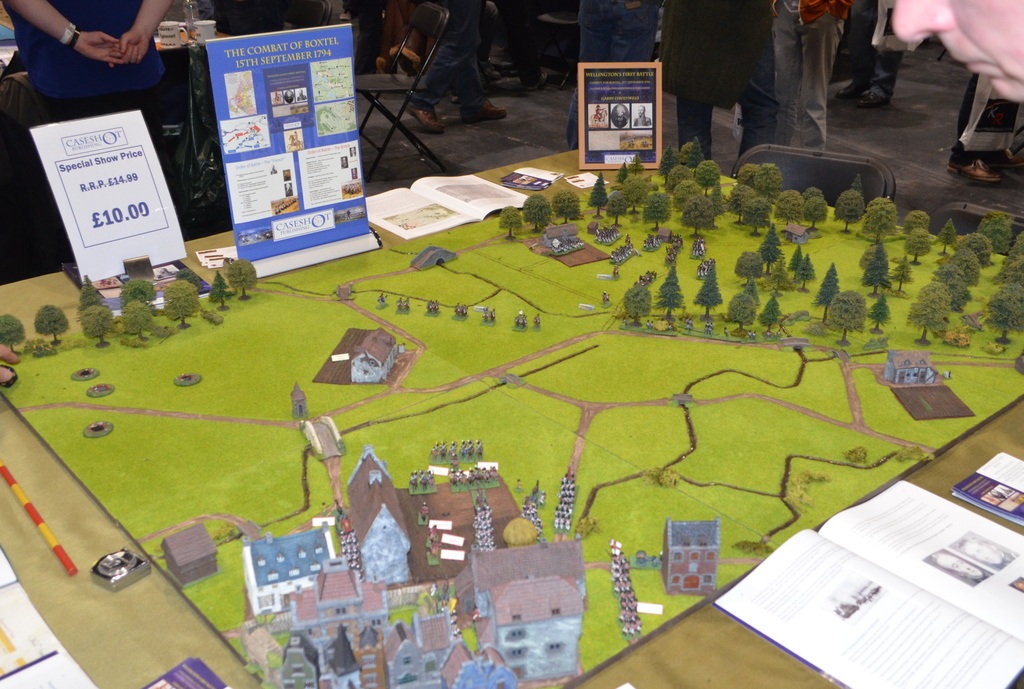








 Nice light and airy venue - the other upstairs hall was splendid
Nice light and airy venue - the other upstairs hall was splendid
 The table set up with plenty of room for supporting materials
The table set up with plenty of room for supporting materials
 As the British emerge from Schyndel they can see the French vedettes in the early morning mist
As the British emerge from Schyndel they can see the French vedettes in the early morning mist
 Daendels brigade is struggling to get forward as it can't use "brigade moves" in the first two turns
Daendels brigade is struggling to get forward as it can't use "brigade moves" in the first two turns
 The British Light Dragoons advance boldly to drive off the French Hussars .....
The British Light Dragoons advance boldly to drive off the French Hussars .....
 ... only to be broken in the ensuing cavalry combat and resulting sweeping advance. Meanwhile Daendels finally gets his brigade moving forward - his battalion guns looking for the convenient bridge.
... only to be broken in the ensuing cavalry combat and resulting sweeping advance. Meanwhile Daendels finally gets his brigade moving forward - his battalion guns looking for the convenient bridge.
 The French Hussars are driven off by the advancing British Guards
The French Hussars are driven off by the advancing British Guards
 Wesley's brigade looks on from their position in reserve near Schyndel
Wesley's brigade looks on from their position in reserve near Schyndel
 The French infantry arrive to drive back the British Guards, breaking the First Foot Guards
Some links featuring other photographs of the game;
The French infantry arrive to drive back the British Guards, breaking the First Foot Guards
Some links featuring other photographs of the game;
 The strong sun dispersing the mist rather quicker than happened on 15th September 1794, revealing the British emerging from Schyndel on the right, while the French are deployed to the left, their hussars keeping close to their supporting light infantry. Although the action is known to history as the combat of Boxtel, that town is actually two game board lengths away from the heart of the action.
The strong sun dispersing the mist rather quicker than happened on 15th September 1794, revealing the British emerging from Schyndel on the right, while the French are deployed to the left, their hussars keeping close to their supporting light infantry. Although the action is known to history as the combat of Boxtel, that town is actually two game board lengths away from the heart of the action.
 The French deployment with most of their strength not directly visible from Schyndel. Daendels' 6 battalion brigade deployed behind Chassé's advanced guard.
The French deployment with most of their strength not directly visible from Schyndel. Daendels' 6 battalion brigade deployed behind Chassé's advanced guard.
 The British advance with the Light Dragoons moving ahead of the Guards brigade with Wesley's (i.e. Wellington) 3rd Brigade bringing up the rear.
The British advance with the Light Dragoons moving ahead of the Guards brigade with Wesley's (i.e. Wellington) 3rd Brigade bringing up the rear.
 Delmas trying to bring up two reluctant battalions which failed successive Black Powder command rolls.
Delmas trying to bring up two reluctant battalions which failed successive Black Powder command rolls.
 The Guards light companies facing off the French light infantry on the right, supported by the 44th Foot.
The Guards light companies facing off the French light infantry on the right, supported by the 44th Foot.
 The crisis approaches as the Guards brigade deploys across the main road to Boxtel, repulsing the French attack by breaking Daendels' brigade. Each pair of battalion guns on both sides are represented by a model gun with a single crew figure and reduced Black Powder fire effect.
The crisis approaches as the Guards brigade deploys across the main road to Boxtel, repulsing the French attack by breaking Daendels' brigade. Each pair of battalion guns on both sides are represented by a model gun with a single crew figure and reduced Black Powder fire effect. 


 The French 8 pdr Horse Artillery of the 4th Company 9th Artillery, supporting the skirmishers of the 3rd Battalion of the 30th Light Demibrigade , both units recruited from a mixture of Dutch, Belgian and Swiss soldiers in exile. These figures are all Minifigs.
The French 8 pdr Horse Artillery of the 4th Company 9th Artillery, supporting the skirmishers of the 3rd Battalion of the 30th Light Demibrigade , both units recruited from a mixture of Dutch, Belgian and Swiss soldiers in exile. These figures are all Minifigs.
 A close up of the British marching out of Schyndel, these figures are all 15mm Minifigs, with the exception of the general figures, which are from the Wessex AWI range.
A close up of the British marching out of Schyndel, these figures are all 15mm Minifigs, with the exception of the general figures, which are from the Wessex AWI range.
 On the French right, Daendels' 29th and 199th Demibrigades de Bataille advance to contact, the figures are a mixture of Minifigs and Magister Militum figures.
[singlepic id=119 w=600 float=center]
On the French right, Daendels' 29th and 199th Demibrigades de Bataille advance to contact, the figures are a mixture of Minifigs and Magister Militum figures.
[singlepic id=119 w=600 float=center]
 The climax of the action as the British Guards have advanced in line, they are about to push back the French light troops but in turn the Guards were forced to retire by Daendels' infantry and the game ended in a draw.
The climax of the action as the British Guards have advanced in line, they are about to push back the French light troops but in turn the Guards were forced to retire by Daendels' infantry and the game ended in a draw.
 Another shot of the climax, with the young Lt. Col. Arthur Wesley, future Arthur Wellesley, Duke of Wellington, in the bottom right of the image, preparing to form the 33rd Foot into line to protect the retreat of the Guards Brigade. He is wearing a very modern bicorne for the 1790's!
Another shot of the climax, with the young Lt. Col. Arthur Wesley, future Arthur Wellesley, Duke of Wellington, in the bottom right of the image, preparing to form the 33rd Foot into line to protect the retreat of the Guards Brigade. He is wearing a very modern bicorne for the 1790's!
 Dugommier's "Division" assembled for the assault, including the young Napoleon, Victor, Junot and Marmont;
Dugommier's "Division" assembled for the assault, including the young Napoleon, Victor, Junot and Marmont;
 Victor assaults the Saint Louis Redoubt;
Victor assaults the Saint Louis Redoubt;
 Brule advances to attack Fort Mulgrave itself;
Brule advances to attack Fort Mulgrave itself;
 and finally J.O.B's print showing Napoleon leading the reserve troops into the redoubt
and finally J.O.B's print showing Napoleon leading the reserve troops into the redoubt


 Denis chose Skugorevo because “it was situated on a hill which overlooked the neighbouring area, so that on a clear day one could see out to a distance of 7 or 8 miles” (5). See the map below.
Denis chose Skugorevo because “it was situated on a hill which overlooked the neighbouring area, so that on a clear day one could see out to a distance of 7 or 8 miles” (5). See the map below.

 The following table is a list of the contacts that Denis Davidov’s force made with the French plus some other key information points drawn from the Memoir.
The following table is a list of the contacts that Denis Davidov’s force made with the French plus some other key information points drawn from the Memoir.
 Of these several actions I have picked four examples which I hope will illustrate the whole;
2nd September - Tsarevo-Zaymische: Denis discovered that a convoy of some munitions wagons and 250 cavalrymen were staying in this village. In his own words the attack proceeded as follows;
Of these several actions I have picked four examples which I hope will illustrate the whole;
2nd September - Tsarevo-Zaymische: Denis discovered that a convoy of some munitions wagons and 250 cavalrymen were staying in this village. In his own words the attack proceeded as follows;

 This simulates the reality that there was considerable debate regarding the strength of the force that should be allocated to Denis. These troops should all be considered as Veterans as Bagration ordered that Davidov be given the best troops(14). Each hussar squadron should be approximately 100 men strong (i.e. 3 figures at 1:33 ratio and 5 figures at 1:20 ratio) and each cossack sotnia should be approximately 60 men strong ( i.e. 2 figures at 1:33 ratio and 3 figures at 1:20 ratio).
This simulates the reality that there was considerable debate regarding the strength of the force that should be allocated to Denis. These troops should all be considered as Veterans as Bagration ordered that Davidov be given the best troops(14). Each hussar squadron should be approximately 100 men strong (i.e. 3 figures at 1:33 ratio and 5 figures at 1:20 ratio) and each cossack sotnia should be approximately 60 men strong ( i.e. 2 figures at 1:33 ratio and 3 figures at 1:20 ratio).



 For streams and the road that the French are moving along, throw 2D6 to determine the entry and exit sectors.
Weather Chart; For each battle, roll 1D20 to determine the prevailing weather for the day;
For streams and the road that the French are moving along, throw 2D6 to determine the entry and exit sectors.
Weather Chart; For each battle, roll 1D20 to determine the prevailing weather for the day;



